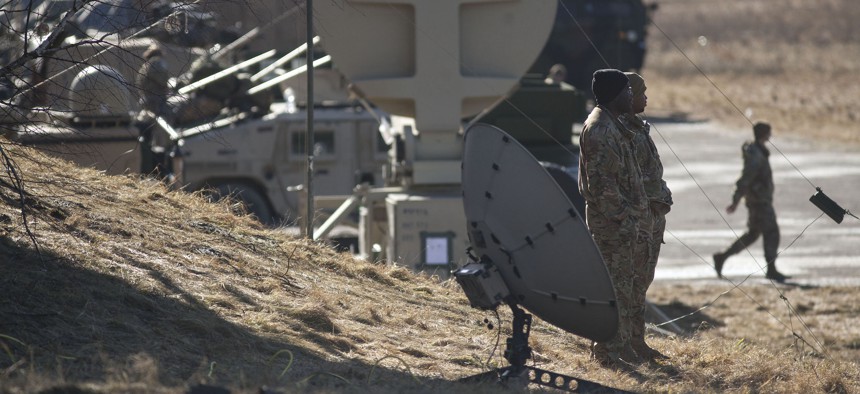
American soldiers sent to the Polish-Ukrainian border on February 24, 2022. Maciej Luczniewski/NurPhoto via Getty Images
Army Preps for ‘Contested Logistics,’ Works to Boost Arms Production
Logistics win wars—but not if new enemy capabilities can disrupt supply lines.
Enemies can be expected to target U.S. supply lines in tomorrow’s wars—with drones, cyber attacks, and other new methods—so the Army and DARPA are working to stay a step ahead, officials said Wednesday.
“We've gone to war in the past with extremely large and, frankly, vulnerable supply lines. It's an American way of war—war through logistics. It's one of our greatest strengths,” Assistant Secretary of the Army for Acquisition, Logistics and Technology Doug Bush said at a DARPA event. “But in doing so we do create a vulnerability that a sophisticated enemy could interdict.”
Bush and others described logistics as a top Army modernization priority.
“We need less energy demand in the front and we need more energy capacity produced at the front to dramatically shrink what those supply lines look like,” Bush said. He identified “dramatically reducing the energy demand of our weapons systems and platforms” while concurrently “dramatically increasing our ability to generate energy in the field” as one of DARPA’s top Army priorities.
The supply playbook also needs an update to prepare for possible near-future conflicts in the Pacific region.
“One of the things the Army does well is logistics. We just have to move it by sea, and we have to make sure we work with the Navy,” Army Chief of Staff Gen. James McConville said at a POLITICO Live event. “We believe we’ll have what we call contested logistics. We’re going to have to work our way through it, just like we’re doing in Europe. And we will apply the appropriate measures to make sure we can do that.”
Meanwhile, the Army is working to produce more weapons and equipment to keep up with the consumption rates of ammunition in Ukraine.
“We’re in the process,” McConville said. “You’ve probably seen the news, we’re replenishing ammunition and weapons systems as we go along. We need to do that.”
The Army is also working to “ramp up our organic industrial base, both in the United States and around the world,” McConville said. So the next time a foreign country requires significant portions of America’s weapons stockpile, it can replenish more quickly.
Just this week, the Army announced several contracts—$520.814 million to Lockheed Martin for Guided Multiple Launch Rocket Systems and $14.357 million to Lockheed Martin to increase funding for the High Mobility Artillery Rocket System. Both contracts specifically included that they aimed to “replenish” DOD stocks provided to Ukraine.
But the process itself also needs to be updated. Bush identified modernizing ammunition production processes as one of his top two priorities for Army modernization, the other being networks for unmanned systems.
“Everybody forgets about producing ammunition until there's a conflict,” Bush said. “We need much more modern ways to do it. I think if any of you were to go and tour some of our ammunition plants, you would see just how old these processes are. We have great Americans working there, but we should find a way to make it safer and more automated.”
“It isn’t the sexiest thing, frankly, the Army does, but it is very important,” Army Secretary Christine Wormuth said at the DARPA event. “Just look at how the Russian military in Ukraine has struggled to resupply and feed its soldiers. That shows you the importance of logistics today on a contested battlefield.”




